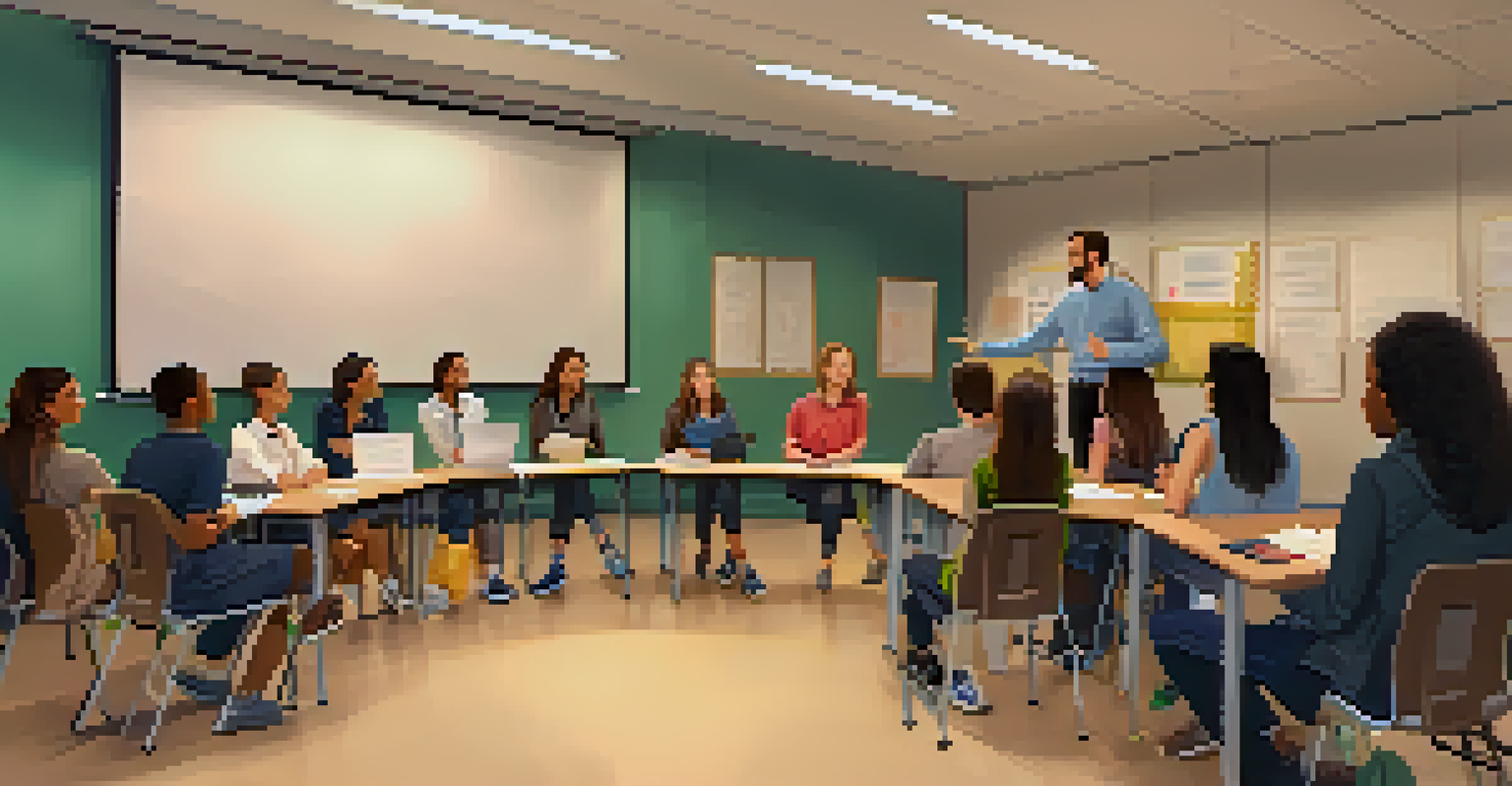Utilizing Peer Feedback in Blended Learning Settings

Understanding Blended Learning and Its Benefits
Blended learning combines traditional classroom methods with online activities, creating a flexible learning environment. This approach allows students to learn at their own pace while still benefiting from face-to-face interactions. By merging these two modes, educators can tailor their teaching to meet diverse learning styles and foster deeper engagement.
Feedback is the breakfast of champions.
One major advantage of blended learning is the increased accessibility it offers. Students can revisit materials and participate in discussions online, making it easier for them to grasp complex concepts. Additionally, this format encourages collaboration, as learners often work together on projects and share insights across various platforms.
Ultimately, blended learning prepares students for the realities of modern education and the workforce, where digital literacy and collaboration are key. As we explore the role of peer feedback in this setting, it's important to recognize how it enhances both learning outcomes and personal growth.
The Role of Peer Feedback in Learning
Peer feedback is an essential component of the learning process, as it encourages students to engage critically with each other's work. This practice not only helps learners gain new perspectives, but it also fosters a sense of responsibility for their peers' success. When students provide constructive feedback, they are better able to reflect on their own understanding.

Moreover, peer feedback promotes active learning, where students become more involved in their educational journey. Instead of passively receiving information, they take on the role of both the giver and receiver of feedback. This two-way interaction can lead to increased motivation and a deeper connection to the subject matter.
Blended Learning Enhances Flexibility
Blended learning merges traditional and online methods, allowing students to learn at their own pace while enjoying face-to-face interactions.
In blended learning environments, peer feedback can take many forms, from online comments to in-person discussions. By integrating various feedback methods, educators can create a rich tapestry of learning experiences that support collaboration and growth.
Creating a Safe Environment for Feedback
For peer feedback to be effective, it's crucial to establish a safe and supportive environment. Students need to feel comfortable sharing their thoughts without the fear of judgment. Educators can help foster this atmosphere by setting clear expectations and guidelines for constructive criticism.
The ability to learn is the most important quality a leader can have.
Encouraging a growth mindset is key in this process. When students understand that feedback is meant to help them improve, they are more likely to embrace it. Celebrating progress and effort, rather than just the end result, can motivate learners to view feedback as a valuable tool for their development.
Additionally, incorporating icebreaker activities or team-building exercises can help students build rapport with one another. When learners feel connected, they're more likely to engage in open and honest discussions, enhancing the overall peer feedback experience.
Strategies for Implementing Peer Feedback
To effectively implement peer feedback, educators can introduce structured guidelines that outline how to give and receive feedback. These guidelines can include specific questions or prompts that guide students in their reviews, ensuring that feedback remains focused and constructive. By providing a clear framework, students can more confidently participate in the feedback process.
Utilizing technology can also enhance peer feedback in blended learning settings. Platforms like Google Classroom or discussion forums allow students to share work and provide feedback asynchronously. This flexibility empowers students to take their time in reflecting on their peers' work and crafting thoughtful responses.
Peer Feedback Promotes Engagement
Engaging in peer feedback encourages students to critically analyze work and fosters a sense of responsibility for their peers' success.
Moreover, incorporating peer feedback into assessments can increase its value. By making it a part of the grading rubric or providing opportunities for revision based on feedback, students are more likely to take the process seriously and engage deeply with their peers' insights.
Training Students to Provide Constructive Feedback
To ensure that peer feedback is productive, it's important to train students on how to provide constructive comments. Educators can introduce techniques such as the 'sandwich method,' which involves starting with a positive remark, followed by areas for improvement, and concluding with another positive note. This approach helps maintain a supportive tone while delivering critical insights.
Role-playing exercises can also be beneficial. By simulating feedback sessions, students can practice articulating their thoughts in a respectful manner. This hands-on practice can build their confidence and help them understand the impact of their words on their peers' learning experiences.
Furthermore, sharing examples of effective feedback can clarify expectations. Educators can analyze real feedback examples with students, discussing what worked well and what could have been improved. This collaborative analysis helps students develop their feedback skills more effectively.
Evaluating the Impact of Peer Feedback
After implementing peer feedback strategies, it's essential to evaluate their effectiveness. Educators can gather qualitative and quantitative data through surveys, reflections, and assessments. By analyzing this information, they can determine how peer feedback has influenced student engagement and learning outcomes.
Encouraging students to reflect on their feedback experiences is also valuable. This reflection can help learners articulate the benefits they gained, such as improved understanding or enhanced communication skills. These insights can guide future peer feedback sessions and foster a culture of continuous improvement.
Creating a Safe Feedback Culture
Establishing a supportive environment is crucial for effective peer feedback, helping students feel comfortable sharing their thoughts.
Ultimately, evaluating the impact of peer feedback can inform teaching practices and lead to better learning experiences. By understanding what works and what doesn't, educators can refine their approaches and ensure that peer feedback remains a powerful tool in blended learning environments.
Fostering a Culture of Continuous Improvement
Creating a culture of continuous improvement is vital in blended learning settings, and peer feedback plays a significant role in this process. When students regularly exchange feedback, they develop a mindset focused on growth rather than perfection. This shift in perspective can lead to a more resilient and adaptable group of learners.
Encouraging ongoing dialogue about feedback helps reinforce its importance. Educators can facilitate discussions around the challenges and successes of providing feedback, empowering students to share their experiences. This open communication fosters a sense of community, where learners feel invested in each other's growth.

Moreover, celebrating achievements and milestones can motivate students to engage in the feedback process. Recognizing individual and group progress not only boosts morale but also emphasizes the value of collaboration. As students continue to learn from one another, they contribute to an enriching and dynamic learning environment.